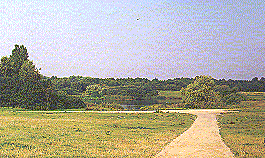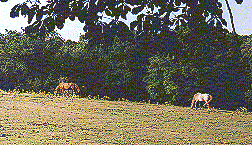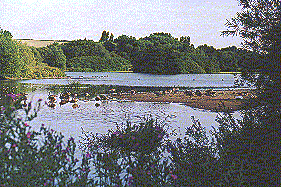Bestwood Country Park
The Country Park is situated immediately to the North of the City of
Nottingham and includes a mixture of mixed woodland, famland and open water.
While not being worth a long trip to visit on its own, if you are visiting
the Nottingham area it is worth a detour and provides a different type
of bird watching to the numerous sites along the River Trent within the
City. As with most sites, early morning is best especially for the
woods around Bestwood Lodge Hotel although evenings at the Mill Lakes can
be quite good.
 There
are two main access points with good parking. The first is in Bestwood
village. From Nottingham take the A611 towards Hucknall. After
passing Bulwell Forest Golf course on your left, turn right down the B683
into Bestwood village. Take the first right (which is currently signposted
"Bestwood Country Park") and the car park is on the right immediately after
the road bends left. You should see the building to the left from
the car park Note the feral pigeons in this picture, sometimes a
Kestrel perches here.
There
are two main access points with good parking. The first is in Bestwood
village. From Nottingham take the A611 towards Hucknall. After
passing Bulwell Forest Golf course on your left, turn right down the B683
into Bestwood village. Take the first right (which is currently signposted
"Bestwood Country Park") and the car park is on the right immediately after
the road bends left. You should see the building to the left from
the car park Note the feral pigeons in this picture, sometimes a
Kestrel perches here.
 From
the car park you can head in almost any direction on foot, but the most
productive area is likely to be the Mill lakes. To access these,
walk back into the village and turn right when you get to the B683.
After walking a few hundred meters you will see a sign for "Mill Lakes"
pointing down a narrow lane off to the left. Take this and you will
come to the main lake (see right). You can walk around this and also
access the area to the right if you continue down the path and turn right
immediately after crossing the stream (River Leen).
From
the car park you can head in almost any direction on foot, but the most
productive area is likely to be the Mill lakes. To access these,
walk back into the village and turn right when you get to the B683.
After walking a few hundred meters you will see a sign for "Mill Lakes"
pointing down a narrow lane off to the left. Take this and you will
come to the main lake (see right). You can walk around this and also
access the area to the right if you continue down the path and turn right
immediately after crossing the stream (River Leen).
 To
reach the other car park, drive back to the A611, turn left towards Nottingham
then take the first left (Bestwood Park Drive West). Cross two roundabouts
and one mini roundabout then take the left signposted "Bestwood Country
Park" before you reach the next T-junction. Follow this road for
about 1 km towards the Bestwood lodge hotel and park on the right before
reaching the hotel. You can walk through the hotel grounds (entrance
on opposite side of road from car park) and into the woods. Useful
signs around the Country Park should enable you to navigate.
To
reach the other car park, drive back to the A611, turn left towards Nottingham
then take the first left (Bestwood Park Drive West). Cross two roundabouts
and one mini roundabout then take the left signposted "Bestwood Country
Park" before you reach the next T-junction. Follow this road for
about 1 km towards the Bestwood lodge hotel and park on the right before
reaching the hotel. You can walk through the hotel grounds (entrance
on opposite side of road from car park) and into the woods. Useful
signs around the Country Park should enable you to navigate.
Birds at Bestwood Country Park
I have been visiting the site fairly regularly since 1985 and have
accumulated a list of 97 species which consists mostly of the common woodland
and farmland species together with the commoner duck species. In
1990 Wood Warbler occurred (9th June) in the woods at the back of Bestwood
Lodge Hotel and in the same year a Black-necked Grebe was on the Mill Lakes
(16th September and 22nd September) and a Grasshooper Warbler took up residence
by the main lake (2nd May).
 The
woods, best visited in early morning in Winter or Spring, hold flocks of
tits, finches and thrushes in Winter and the commoner warblers in Spring.
The area around the stables can be quite good as can the feeders by Alexandra
Lodge. Check the school field on your left as you walk into the woods
for gulls in Winter. The Mill Lakes hold a good variety of the commoner
duck in Winter including Teal, Pochard, Tufted Duck, Mallard, Wigeon, Gadwall,
Goldeneye (occasionally) and Ruddy Duck. Great Crested and Little
Grebe occur and I have seen up to 10 of the latter. Little Ringed
Plover have bred nearby and visit a small patch of exposed mud on the main
lake. Grey Heron and Mute Swan are usually present as is a large
flock of Canada Geese. Check the patch of exposed mud (see picture
right) at the northern end of the main lake for waders - I have seen Little
Ringed Plover and Snipe. Lapwing use the surrounding fields.
Kingfisher are present as are all the common corvids - Magpie, Carrion
Crow around the lakes typically with Jay, Jackdaw and Rook more likely
in the woods and surrounding fields.
The
woods, best visited in early morning in Winter or Spring, hold flocks of
tits, finches and thrushes in Winter and the commoner warblers in Spring.
The area around the stables can be quite good as can the feeders by Alexandra
Lodge. Check the school field on your left as you walk into the woods
for gulls in Winter. The Mill Lakes hold a good variety of the commoner
duck in Winter including Teal, Pochard, Tufted Duck, Mallard, Wigeon, Gadwall,
Goldeneye (occasionally) and Ruddy Duck. Great Crested and Little
Grebe occur and I have seen up to 10 of the latter. Little Ringed
Plover have bred nearby and visit a small patch of exposed mud on the main
lake. Grey Heron and Mute Swan are usually present as is a large
flock of Canada Geese. Check the patch of exposed mud (see picture
right) at the northern end of the main lake for waders - I have seen Little
Ringed Plover and Snipe. Lapwing use the surrounding fields.
Kingfisher are present as are all the common corvids - Magpie, Carrion
Crow around the lakes typically with Jay, Jackdaw and Rook more likely
in the woods and surrounding fields.
On a quiet day you might struggle to see more than 20 species but on a
reasonable day 30 plus species are quite easy to locate. In 2003, I have
seen 39 (19 Jan), 40 (18 Feb), 35 (22 March) and 37 (5 April) species during a
two and a half hour walk around the Mill Lakes and the countryside immediately
surrounding Bestwood Village.
List of birds seen so far this year (2003):
Little
Grebe, Great Crested Grebe, Cormorant, Grey Heron, Mute Swan, Canada Goose,
Wigeon, Gadwall, Teal, Mallard, Pochard, Tufted Duck, Sparrowhawk, Kestrel,
Moorhen, Coot, Common Gull, Black-headed Gull, Stock Dove, Woodpigeon, Collared
Dove, Green Woodpecker, Skylark, Pied Wagtail, Meadow Pipit, Wren, Dunnock,
Blackbird, Redwing, Song Thrush, Mistle Thrush, Chiffchaff, Robin, Long-tailed
Tit, Willow Tit, Coal Tit, Great Tit, Blue Tit, Jay, Magpie, Jackdaw, Rook,
Carrion Crow, Starling, House Sparrow, Chaffinch, Greenfinch, Siskin, Goldfinch,
Linnet,
Bullfinch. (Total = 51)
The full list of birds I have seen in Bestwood Country Park since 1986 is as follows:
Little
Grebe, Great Crested Grebe, Black-necked Grebe, Cormorant, Grey Heron, Mute
Swan, Greylag Goose, Canada Goose, Shelduck, Wigeon, Gadwall, Teal, Mallard,
Shoveler, Pochard, Tufted Duck, Goldeneye, Ruddy Duck, Sparrowhawk, Kestrel,
Red-legged Partridge, Grey Partridge, Pheasant, Water Rail, Moorhen, Coot,
Lapwing, Little Ringed Plover, Snipe, Common Sandpiper, Common Gull, Herring
Gull, Lesser Black-backed Gull, Black-headed Gull, Stock Dove, Woodpigeon,
Turtle Dove, Collared Dove, Cuckoo, Tawny Owl, Swift, Kingfisher, Great Spotted
Woodpecker, Green Woodpecker, Skylark, Sand Martin, Barn Swallow, House Martin,
Pied Wagtail, Yellow Wagtail, Meadow Pipit, Goldcrest, Wren, Dunnock, Blackbird,
Fieldfare, Redwing, Song Thrush, Mistle Thrush, Grasshopper Warbler, Sedge
Warbler, Reed Warbler, Willow Warbler, Chiffchaff, Wood Warbler, Blackcap,
Garden Warbler, Whitethroat, Lesser Whitethroat, Spotted Flycatcher, Robin,
Long-tailed Tit, Marsh Tit, Willow Tit, Coal Tit, Great Tit, Blue Tit, Nuthatch,
Treecreeper, Jay, Magpie, Jackdaw, Rook, Carrion Crow, Starling, House Sparrow,
Tree Sparrow, Chaffinch, Brambling, Greenfinch, Redpoll, Siskin, Goldfinch,
Linnet, Bullfinch, Yellowhammer, Reed Bunting, Corn Bunting. (Total = 98)
 There
are two main access points with good parking. The first is in Bestwood
village. From Nottingham take the A611 towards Hucknall. After
passing Bulwell Forest Golf course on your left, turn right down the B683
into Bestwood village. Take the first right (which is currently signposted
"Bestwood Country Park") and the car park is on the right immediately after
the road bends left. You should see the building to the left from
the car park Note the feral pigeons in this picture, sometimes a
Kestrel perches here.
There
are two main access points with good parking. The first is in Bestwood
village. From Nottingham take the A611 towards Hucknall. After
passing Bulwell Forest Golf course on your left, turn right down the B683
into Bestwood village. Take the first right (which is currently signposted
"Bestwood Country Park") and the car park is on the right immediately after
the road bends left. You should see the building to the left from
the car park Note the feral pigeons in this picture, sometimes a
Kestrel perches here.
 From
the car park you can head in almost any direction on foot, but the most
productive area is likely to be the Mill lakes. To access these,
walk back into the village and turn right when you get to the B683.
After walking a few hundred meters you will see a sign for "Mill Lakes"
pointing down a narrow lane off to the left. Take this and you will
come to the main lake (see right). You can walk around this and also
access the area to the right if you continue down the path and turn right
immediately after crossing the stream (River Leen).
From
the car park you can head in almost any direction on foot, but the most
productive area is likely to be the Mill lakes. To access these,
walk back into the village and turn right when you get to the B683.
After walking a few hundred meters you will see a sign for "Mill Lakes"
pointing down a narrow lane off to the left. Take this and you will
come to the main lake (see right). You can walk around this and also
access the area to the right if you continue down the path and turn right
immediately after crossing the stream (River Leen).
 To
reach the other car park, drive back to the A611, turn left towards Nottingham
then take the first left (Bestwood Park Drive West). Cross two roundabouts
and one mini roundabout then take the left signposted "Bestwood Country
Park" before you reach the next T-junction. Follow this road for
about 1 km towards the Bestwood lodge hotel and park on the right before
reaching the hotel. You can walk through the hotel grounds (entrance
on opposite side of road from car park) and into the woods. Useful
signs around the Country Park should enable you to navigate.
To
reach the other car park, drive back to the A611, turn left towards Nottingham
then take the first left (Bestwood Park Drive West). Cross two roundabouts
and one mini roundabout then take the left signposted "Bestwood Country
Park" before you reach the next T-junction. Follow this road for
about 1 km towards the Bestwood lodge hotel and park on the right before
reaching the hotel. You can walk through the hotel grounds (entrance
on opposite side of road from car park) and into the woods. Useful
signs around the Country Park should enable you to navigate.
 The
woods, best visited in early morning in Winter or Spring, hold flocks of
tits, finches and thrushes in Winter and the commoner warblers in Spring.
The area around the stables can be quite good as can the feeders by Alexandra
Lodge. Check the school field on your left as you walk into the woods
for gulls in Winter. The Mill Lakes hold a good variety of the commoner
duck in Winter including Teal, Pochard, Tufted Duck, Mallard, Wigeon, Gadwall,
Goldeneye (occasionally) and Ruddy Duck. Great Crested and Little
Grebe occur and I have seen up to 10 of the latter. Little Ringed
Plover have bred nearby and visit a small patch of exposed mud on the main
lake. Grey Heron and Mute Swan are usually present as is a large
flock of Canada Geese. Check the patch of exposed mud (see picture
right) at the northern end of the main lake for waders - I have seen Little
Ringed Plover and Snipe. Lapwing use the surrounding fields.
Kingfisher are present as are all the common corvids - Magpie, Carrion
Crow around the lakes typically with Jay, Jackdaw and Rook more likely
in the woods and surrounding fields.
The
woods, best visited in early morning in Winter or Spring, hold flocks of
tits, finches and thrushes in Winter and the commoner warblers in Spring.
The area around the stables can be quite good as can the feeders by Alexandra
Lodge. Check the school field on your left as you walk into the woods
for gulls in Winter. The Mill Lakes hold a good variety of the commoner
duck in Winter including Teal, Pochard, Tufted Duck, Mallard, Wigeon, Gadwall,
Goldeneye (occasionally) and Ruddy Duck. Great Crested and Little
Grebe occur and I have seen up to 10 of the latter. Little Ringed
Plover have bred nearby and visit a small patch of exposed mud on the main
lake. Grey Heron and Mute Swan are usually present as is a large
flock of Canada Geese. Check the patch of exposed mud (see picture
right) at the northern end of the main lake for waders - I have seen Little
Ringed Plover and Snipe. Lapwing use the surrounding fields.
Kingfisher are present as are all the common corvids - Magpie, Carrion
Crow around the lakes typically with Jay, Jackdaw and Rook more likely
in the woods and surrounding fields.